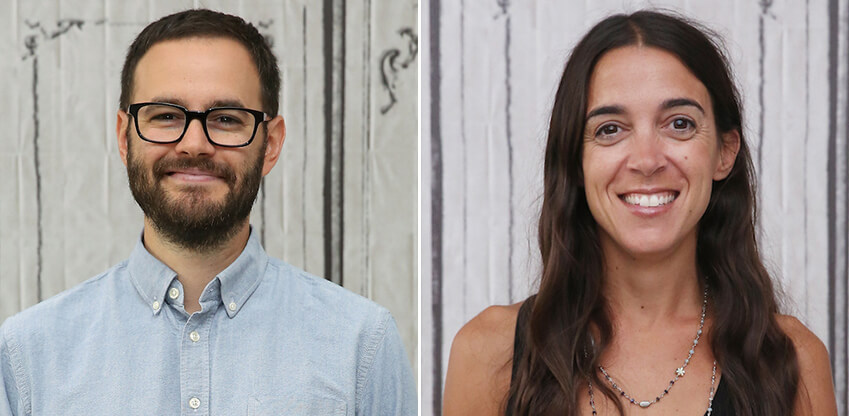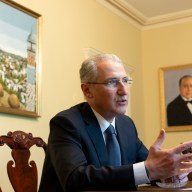Steve Gleason is doing well, all things considered. The former Saints safety was diagnosed with ALS in 2011. In the new documentary “Gleason” we see his bodily collapse step-by-step; it ends with him completely paralyzed, unable to eat or speak, communicating through a cutting-edge computer program. According to his wife, Michel Rae Varisco — the film’s other main “star” — at least it hasn’t gotten worse. “The good thing is he suffered — most likely — all the loss he will have to suffer,” Varisco tells us. “He is what he is, and we’ve been through that traumatic time. Now, instead of focusing on the loss, we’re focusing on what he can actually do.” They have been busy. Since its Sundance premiere, Varisco, Gleason and their young son, River, have been on a nation-wide press tour. It’s not easy: Varisco says any travel requires not only a bulk of equipment but two more caretakers than usual, though that’s not a bad thing for someone who needs constant care. And they’ve gotten pros at it: By now they know how to get Gleason into a car, which headrest is best, etc. RELATED: Review: “Gleason” is more than a mere triumph-of-the-human-spirit doc The film itself is lucky to exist, at least in its singularly intimate form. The film is made of footage they either shot themselves in the early days or by filmmakers they hired when things got rough. In 2014, they roped in Clay Tweel, a documentarian (of the more slightly more light-hearted “Finders Keepers,” about a man who finds an amputated leg in his new grill), to film more footage and piece it together into what became “Gleason.” “We wanted to make a film that was going to be true to ALS patients’ stories,” Tweel says. “If we were going to tell a story that was a pure hero piece with rose-tinted glasses on, it would be false. It would be something that would anger patients and their families.” That meant finding a balance between heartbreak and humor — which is how Gleason and Varisco have dealt with his condition. “Anyone who’s ever been in a room with Steve and Michel knows they have this zestful life. You can feel that when you’re around them,” Tweel says. “The reality of ALS and the day-to-day challenges can be hard to watch sometimes. We wanted to show both of those and have them interwoven — to show what the truth of their experiences are.” Varisco wasn’t wary of having her real life on a movie screen, at least at first. “I had no idea it was going to be a movie of this size. Had I known that I’d be talking to [reporters] today, I probably would have had a bit more trepidation,” Varisco says of the first stage of filming, which originated as video diaries Gleason recorded so he could speak to his son before ALS escalated. “I didn’t really pay attention to it until Clay showed us the first cut,” Varisco explains. But she was happy Tweel understood that they didn’t want a film that was merely a triumph-of-the-human-spirit deal. “Early on Steve and I said, ‘If we’re going to do this we’re going to make this as raw and honest as possible. I could see from the first cut Clay was not going to shy away from that.” Tweel wound up having to hack 1300 hours of footage into a two-hour movie. The result is a film that focuses on the pain and the gallows humor, and which is equally about Gleason and Varisco. Tweel points out that many films about diseases don’t dwell on the plight of care-takers or reduce spouses and loved ones to mere support systems. He actually had a history watching people grapple with a disease: His father was Muhammad Ali’s lawyer for 30 years. He saw both he and his wife, Yolanda Williams, battle with his Parkinson’s. RELATED:Sarah Gadon and Logan Lerman on the odd way they met on Indignation” “I watched someone be a public sports hero and live the realities of Parkinson’s and how that affected his family,” Tweel says. “I felt I was in a unique position to help Steve and Michel tell their story. That’s something I talked about when I went down to meet them for the first time. I let them know my personal connection to their story, and the passion I would bring to it because of that. There are so many parallels in the personality traits of everyone involved.” Watching “Gleason” is not only an aggressive emotional experience; it also helps raise awareness of helping those with ALS. Since the film’s completion, Gleason has been working with Microsoft to create better tech, including a wheelchair that can be controlled with the eyes. And he’s the star of a film that shows both the tears and the pain of his experiences, but also the way jokes bring levity, no less in a long scene in which everyone struggles to help him use the bathroom. “That scene plays in what Steve talks about: the juxtaposition of life,” Tweel says. “One minute he gets a statue dedicated to him. The next minute he’s crapping his pants. That’s what life is like.”
Clay Tweel and Michel Rae Varisco on finding the humor in the doc ‘Gleason’

Getty Images
Follow Matt Prigge on Twitter @mattprigge
















